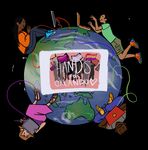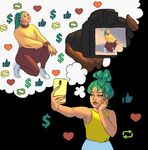Youth and the Digital Economy: Exploring Youth Practices, Motivations, Skills, Pathways, and Value Creation - Harvard DASH
←
→
Page content transcription
If your browser does not render page correctly, please read the page content below
Youth and the Digital Economy:
Exploring Youth Practices, Motivations,
Skills, Pathways, and Value Creation
The Harvard community has made this
article openly available. Please share how
this access benefits you. Your story matters
Citation Lombana-Bermudez, Andres, Sandra Cortesi, Christian Fieseler,
Urs Gasser, Alexa Hasse, Gemma Newlands, and Sarah Wu. “Youth
and the Digital Economy: Exploring Youth Practices, Motivations,
Skills, Pathways, and Value Creation,” Youth and Media, Berkman
Klein Center for Internet & Society (2020).
Citable link http://nrs.harvard.edu/urn-3:HUL.InstRepos:42669835
Terms of Use This article was downloaded from Harvard University’s DASH
repository, and is made available under the terms and conditions
applicable to Other Posted Material, as set forth at http://
nrs.harvard.edu/urn-3:HUL.InstRepos:dash.current.terms-of-
use#LAASpotlight
Series
Youth and the
Digital Economy:
Exploring Youth Practices, Motivations,
Skills, Pathways, and Value Creation
Andres Lombana-Bermudez Sandra Cor tesi Christian Fieseler
Urs Gasser Alexa Hasse Gemma Newlands Sarah Wu
23 Everett St., 2nd Floor
Cambridge, MA 02138, USA
youthandmedia@cyber.harvard.edu
Youth and Media youthandmedia.orgSUGGESTED CITATIONS APA Lombana-Bermudez, A., Cortesi, S., Fieseler, C., Gasser, U., Hasse, A., Newlands, G., & Wu, S. (2020). Youth and the digital economy: Exploring youth practices, motivations, skills, pathways, and value creation. Youth and Media, Berkman Klein Center for Internet & Society. Retrieved from https://cyber.harvard.edu/ publication/2020/youth-and-digital-economy. Chicago (Bibliography) Lombana-Bermudez, Andres, Sandra Cortesi, Christian Fieseler, Urs Gasser, Alexa Hasse, Gemma Newlands, and Sarah Wu. “Youth and the Digital Economy: Exploring Youth Practices, Motivations, Skills, Pathways, and Value Creation,” Youth and Media, Berkman Klein Center for Internet & Society (2020), accessed on [Month Day, Year], https://cyber.harvard.edu/publication/2020/youth-and-digital-economy Chicago (Footnote) Lombana-Bermudez, Andres, et al. “Youth and the Digital Economy: Exploring Youth Practices, Motivations, Skills, Pathways, and Value Creation,” Youth and Media, Berkman Klein Center for Internet & Society (2020), accessed on [Month Day, Year], https://cyber.harvard.edu/publication/2020/youth-and-digital-economy. MLA Lombana-Bermudez, Andres, Sandra Cortesi, Christian Fieseler, Urs Gasser, Alexa Hasse, Gemma Newlands, and Sarah Wu. “Youth and the Digital Economy: Exploring Youth Practices, Motivations, Skills, Pathways, and Value Creation.” Youth and Media, Berkman Klein Center for Internet & Society, 2020. Web. [Day Mon. Year]. . Bluebook Andres Lombana-Bermudez, Sandra Cortesi, Christian Fieseler, Urs Gasser, Alexa Hasse, Gemma Newlands, and Sarah Wu. Youth and The Digital Economy: Exploring Youth Practices, Motivations, Skills, Pathways, and Value Creation (2020), available at https://cyber.harvard.edu/publication/2020/youth-and- digital-economy KEYWORDS Youth, young people, children, adolescents, teenagers, education, high school, middle school, digital media, new media, Internet, ICT, Web, online, digital economy, capital-enhancing activities, aspirational labor, hope labor, virtual collaboration, skills. PUBLICATION DATE June 2020
LICENSE This work is licensed under a Creative Commons Attribution-ShareAlike 4.0 International (CC BY-SA 4.0) license. ACKNOWLEDGEMENTS We are deeply grateful for the research assistance and editorial support provided by the different members of the Berkman Klein Center’s Youth and Media team, including Briggs DeLoach, Tanvi Kanchinadam, Levin Kim, Sonia Kim, Amanda Kraley, and Quinn Robinson. Further, we wish to thank Jessi Whitby for her excellent work on part I of the report. Thanks also to Elsa Brown, Rebecca Smith, and Claudia Thomas for their wonderful graphics and illustrations throughout this publication, Sam Daitzman for her vision behind the presentation of the paper, and to Alex Edgerly for the creative layout and design of the spotlight. We are thankful for Joni McNeal’s (https://www. jonilmcneal.com/) copy editing of this publication. Thanks also to Lionel Brossi, Padmashree Gehl, Nick-Brie Guarriello, Rey Junco, Jasmine McNealy, and Leah Plunkett for reading a draft version of this report and providing comments and feedback, as well as for their important work in this field. We are also grateful to Christoph Lutz at the Nordic Centre, who provided important feedback on essay #1, on youth and capital-enhancing activities. Special thanks are due to Christian Fieseler and his team at the Nordic Centre for their support and collaboration. This work builds upon research enabled by generous funding from the Research Council of Norway within the SAMANSVAR project “Fair Labor in the Digitized Economy” (247725/O70).
Youth and the Digital Economy:
Exploring Youth Practices, Motivations,
Skills, Pathways, and Value Creation
By Andres Lombana-Bermudez, Sandra Cortesi, Christian Fieseler, Urs Gasser, Alexa Hasse,
Gemma Newlands, & Sarah Wu.
Young people’s lives are increasingly shaped by digital technologies. While significant digital divides and
participation gaps remain, an increasing number of young people around the globe participate in and contribute
to the digitally networked environment in many forms, ranging from creative expression on social media to
interactive gaming and collaboration. This spotlight explores young people’s digital engagement through the
lens of the digital economy and seeks to gain an initial understanding of youth’s practices, motivations, skills,
pathways, and modes of value creation as they interact with a digital environment in which the boundaries
between the commercial and personal spheres, between work and play, are often blurring. The spotlight
summarizes key insights from a trans-Atlantic exploratory research collaboration between Youth and Media
at the Berkman Klein Center for Internet & Society at Harvard University and the Nordic Centre for Internet and
Society at BI Norwegian Business School. In addition to sketching building blocks toward a framework, the
paper brings together three essays that explore in different application contexts both the opportunities and
challenges that surface when young people engage with and participate in the digital economy.
4TABLE OF CONTENTS
0. BACKGROUND AND PURPOSE 7
I. FRAMING AND CONTEXT 8
1. Youth Engagement Opportunities 8
2. Digital Divides and Evolving Inequalities 11
3. New Asymmetries 13
4. Introducing the Essays 14
5. A Possible Research Agenda 19
Youth as “Prosumers” 19
Capital-Enhancing Activities 19
Intrinsic and Extrinsic Motivations 20
Developing an Economic Mindset 20
Short-Term and Long-Term Gains 21
Metrics of Youth Value Creation 21
Collaboration and other Socioemotional Skills 21
Young People’s Position in the Digital Economy 21
Digital Labor, Digital Play 22
Youth and Adults: Competition and Collaboration 22
Supporting Youth Enterprise 23
Parental Guidance Advised 23
II. ESSAY 1 — YOUTH AND CAPITAL-ENHANCING ACTIVITIES 24
1. Introduction 25
2. Capital-Enhancing Activities 25
53. Developing Forms of Capital 26
The Sociological Approach 26
Social Capital 27
Cultural Capital 28
Economic Capital and Conversions 29
4. Conclusion 30
III. ESSAY 2 – YOUTH AND ASPIRATIONAL LABOR 31
1. Introduction 31
2. Aspirational Labor: At the Heart of the Issue 32
3. The First Steps to Success: Upsides of Aspirational Labor 35
4. Assessing the True Cost: Downsides of Aspirational Labor 37
5. Conclusion 39
IV. ESSAY 3 – YOUTH AND VIRTUAL COLLABORATION 40
1. Introduction 40
2. Scratch: An Online and Youth-Driven Platform 41
3. Virtual Collaboration and Teamwork in Scratch 42
4. Case Study: “Hands for Orlando,” a Multiple Animator Project 43
Background 43
Levers for Virtual Collaboration 44
Effective Leadership (Unification and Tasking) 44
Trust-building 45
Establishing Common Ground 47
5. Conclusion 48
REFERENCES 49
60. BACKGROUND
AND PURPOSE
Young people’s lives are increasingly shaped Segment two of the spotlight includes three in-depth
by digital technologies. While significant digital essays that further explore in specific application
divides and participation gaps remain, an contexts and from different perspectives the
increasing number of young people around the opportunities and challenges that emerge when
globe participate in and contribute to the digitally young people engage with and participate in the
networked environment in many forms, ranging from digital economy. One essay examines youth-driven
creative expression on social media to interactive capital-enhancing activities such as creating and
gaming and collaboration. This spotlight explores sharing content on social media platforms. A
young people’s digital engagement through the lens second essay examines how young people leverage
of the digital economy and seeks to gain an initial their online activities and skills with an eye to future
understanding of youth’s practices, motivations, employment opportunities — a phenomenon termed
skills, pathways, and modes of value creation as “aspirational labor.” A third essay uses a case study
they interact with a digital environment in which the to zoom in on so-called “soft” skills — such as virtual
boundaries between the commercial and personal collaboration skills — and examines how such skills
spheres, between work and play, are often blurring. might prepare young people to thrive in the digital
economy as a highly networked ecosystem.
The spotlight is divided into two segments. Segment
one provides an introduction to the evolving The spotlight summarizes key insights from a
discourse around youth and the digital economy. trans-Atlantic exploratory research collaboration
It starts with a brief overview of different types between Youth and Media at the Berkman Klein
of youth-engagement opportunities associated Center for Internet & Society at Harvard University
with the proliferation of the Internet, widespread and the Nordic Centre for Internet and Society at BI
adoption of mobile devices, and emergence of Norwegian Business School. It seeks to provide initial
interactive platforms that are at the core of today’s conceptual building blocks and phenomenological
digital economy. Moving from opportunities to insights toward a more comprehensive analysis and
challenges, segment one then addresses the assessment of youth’s engagement in the digital
problem of existing digital divides, as well as the economy and the opportunities and challenges that
risk of new structural inequalities and participation are associated with it.
gaps and also points toward new power asymmetries
between youth as users/producers/consumers and
powerful commercial platforms. It concludes with
12 areas of interest emerging from this project
that deserve further investigation and might
inform a future research agenda.
7I. FRAMING AND CONTEXT
1. YOUTH ENGAGEMENT OPPORTUNITIES
The Internet and digital technologies that run on Scratch or engaging in collaborative fan-
on top of it have unleashed an explosion of fiction projects), among other productive activities
creative opportunities for youth to be active in (Benkler, 2006; Jenkins, 2006; Jenkins et al., 2006;
a “participatory” and “networked” culture, with Ito et al., 2011). A rich body of theoretical work and
low barriers to entry and multiple possibilities for empirical research suggests that youth engagement
widespread content circulation (we will address with online content, platforms, and services can
some of the roadblocks in the following sections). take many forms (Palfrey & Gasser, 2016). Some
Youth can share information and communicate of these newer forms of engagement build upon
their knowledge, connect with interest-driven and complement more traditional forms of content
communities (e.g., video game modding forums), creation. For further illustration, consider the
and cooperate on peer-based production projects following modes of engagement and anecdotes.
(e.g., by contributing to multiple animator projects
8Video Blogging:
Particularly powerful examples of youth participation
in the digital economy are influencers on YouTube,
where tech- and business-savvy young people have
built popular personal brands by creating beauty
and lifestyle videos that emphasize their cultural
and racial specificity, aesthetics, values, and norms.
With thousands, sometimes millions, of viewers
and subscribers, some YouTubers have become
influencers who earn money by displaying third-
party advertising on their content (e.g., the Google
AdSense program) or by partnering with companies
to create videos about specific products and services
(“advertorials”).
Written Blogging:
Written blogs continue to be a site of production and
consumption for youth, both on personal websites
and social media platforms such as Tumblr. Given
the evolution of social media ecosystems, blogs are
usually maintained in coordination with YouTube
and Instagram channels, as well as Facebook
pages. Common examples of youth blogging are
fashion blogs, where young creators cultivate niche
audiences based on particular styles. Besides
maintaining and expanding connections with
readers, they sometimes generate revenue through
affiliations with established fashion brands that
sponsor posts about particular products.
Photography / Art / Design:
Youth, who are passionate about food, nature,
fashion, art, and/or design, have also become avid
contributors on social media (e.g., Instagram and
Snapchat) by posting pictures and photographs
of their passions online, building audiences of
followers. For example, 17-year-old Jose from
Peru, publicly known by the name @naturally.jo on
Instagram, started his path in the digital economy
by posting vegan art and food. Following a common
trajectory, he then later expanded his content
production and circulation to other platforms, such
as YouTube and Facebook, where he continues to
build relationships with his audience.
9Music / Podcasting:
In the music sector, some young people have been
able to build global audiences of listeners, sometimes
counting into the thousands, for their original music
on SoundCloud. In doing so, these young people often
find opportunities to distribute their music, perform
in public venues, and crowdfund the production of - M o r e o v e r,
their albums. Music genres such as “SoundCloud hip -s k i l l e d t e e n s
hop” in the U.S., baile funk in Brazil, and rap urbano engage in “modding,”
in Colombia have grown in recent years due to the which is the practice
creative exchanges, exposure, and community of transforming existing
relationships developed by minority youth online. commercial video games and
For instance, a group of low-income Afro-descended developing additional content for
male youth from Colombia and Brazil or African- public consumption. These modders
American youth from the U.S., have been gaining can thus build their reputations as skilled
popularity on SoundCloud by uploading their music game designers, hoping to eventually be
tracks, networking with other artists, and connecting hired in the professional gaming industry.
to producers and promoters online.
These forms of engagement describe a spectrum
of what is possible. Granted, while social media
platforms may enable youth to express themselves
in many different ways, the majority of young users
tend to engage in relatively modest ways (i.e.,
sharing a few pictures on Instagram or some snaps
on Snapchat). Surveys confirm it is a relatively
small number of young people who extensively post
content and heavily invest in creating ambitious
projects online. It is important to recognize these
facts, as further discussed in the next section
on digital divides and evolving inequalities. That
being said, it is equally important to appreciate the
extent to which all modes of engagement, including
modest engagement, represent opportunities for
learning, identity formation, belonging, and individual
autonomy. Furthermore, what may seem mundane
in isolation, such as a selfie on Instagram, may
Coding / “Modding:” affect societal changes in sum and over time. For
Other young people — often teenagers from more all these reasons, the adult-normative perspective
privileged backgrounds — participate in the digital should arguably be less focused on a given level
economy through their engagement in gaming of engagement and creativity of an individual
culture. Massive Multiplayer Online Games (MMOGs), expression but shift toward the question of how to
such as Roblox, provide not only a virtual world best encourage youth to engage in different ways
where players engage in a variety of adventures, but — whether with pen and paper or through the latest
also virtual studios and markets where youth can digital technologies.
create, test, and commercialize their own games.
10Whether their individual contributions are small or growing popularity of “makerspaces,”’ or community
big, youth engagement online has helped to create spaces centered around creativity, innovation, and
a digital environment that is more diverse in terms group collaboration among youth. While this existing
of voices, perspectives, and information. Diversity, entrepreneurial mindset among youth is promising,
in turn, enables people to access a wider range of significant participation gaps and barriers remain
viewpoints. It allows people (young and old) to have that hinder and sometimes even prevent youth
conversations based on different ideas and creative from engaging in digital activities of the sort
expressions. It also helps drive participation in public described in the following stories (Palfrey
discussions and matters from a broader cultural & Gasser, 2016). Within the specific
perspective. A diverse body of art and literature, context of this spotlight, three
varying lifestyles and ways of living together, roadblocks in particular need to
and different cultures, languages, value systems, be addressed: digital divides,
traditions, and beliefs make our lives more interesting evolving inequalities,
compared to a world full of constraints on creativity and new (power)
and expression. asymmetries.
Another important consequence of an emerging
digital economy is the profound effect it has had
on youth and their ability to be more entrepreneurial
and part of different business ventures. Having a
creative idea, the relevant skills, and some social,
cultural, and financial capital can, in many cases, lay
the groundwork for more entrepreneurial endeavors.
This cultural shift also becomes more apparent in the
2 . D I G I TA L D I V I D E S A N D E V O LV I N G I N E Q U A L I T I E S
Over the past two decades, scholars have Internet (Lombana-Bermudez, 2017; Pearce &
acknowledged the risk that the digital Rice, 2017). The Broadband Commission for
transformation of societies could exacerbate and Sustainable Development reported that in 2017,
reproduce existing inequalities, creating a “digital 52% of the world’s population still does not
divide” of multiple dimensions (DiMaggio et al., have access to the Internet or their access is
2004; Norris, 2001; Warschauer, 2002), which intermittent or of inferior quality (UNICEF, 2017).
could, in turn, also affect the degree to which young Internet-user penetration is vastly different
people can participate in the digital economy. depending on geography. For example, close to
90% of the young people (aged 15–24) currently
The digital divide is multifaceted — inequities not using the Internet live in Africa or Asia and
can come in the form of unequal access to the Pacific (International Telecommunication
technologies (first-level digital divide); unequal Union [ITU], 2017). The participation gap is
development of the relevant skills needed to also evident between those living in rural and
flourish online (second-level digital divide); and the urban areas across the globe, even in highly
disparate benefits of technology usage according connected countries, as demonstrated by the
to socioeconomic status (third-level digital divide) OECD (2018).
(Lombana-Bermudez, 2017; Pearce & Rice, 2017).
1. The “first-level digital divide” describes the
baseline divide — the gap in access to the
112. The “second-level digital divide” describes 3. The “third-level digital divide” describes how
gaps in terms of online skills and practices individuals with higher socioeconomic status
(Hargittai, 2002; Jenkins et al., 2006). For benefit more from online engagement
example, successful social media influencers than those with lower socioeconomic
have developed sophisticated skills to game status (van Deursen & Helsper, 2015;
the algorithms and maximize exposure of van Deursen & van Dijk 2013; van Dijk,
their content. Meanwhile, other youth may be 2005). Although there is a lack of empirical
participating in the digital economy in a less evidence that focuses specifically on content
“advantageous way” — that is, with little impact produced by young people, scholars have
on their social status — such as through passive long recognized there is a digital content-
consumption of media or entertainment, production gap amongst adults that is driven
without an eye toward future benefit. The by socioeconomic status (Schradie, 2011)
difference in the online activity of those in the and other factors, like race (Mack, 2001)
Global North compared with those living in the and gender (Liff et al., 2004). For example,
Global South is pronounced. This “participation youth from the lowest-income countries use
gap” is primarily driven by barriers to access to the Internet the least (UNICEF, 2017). Also,
infrastructure, affordability issues, and lack of particularly in some low-income countries,
relevant local content (Broadband Commission men use the Internet more than women,
for Sustainable Development, 2017). with this gap widening over time (ITU, 2016;
UNICEF, 2017).
Taken together, it becomes apparent that even though
young people as a demographic have a high level of
connectivity, they are not all participating under the
same conditions. Instead, the playing field is
unequal across multiple dimensions, such
as geographic location, the education
level of parents, social class, race,
and gender. The expected result is
that the benefits of connectivity
will accumulate in the hands of
those youth who are already
well-positioned to
12reap the rewards. Conversely, the rising inequality is Given these existing disparities in access to
limiting access to opportunities and social mobility technology, skill levels, and the reasons behind its
(Hargittai 2010; Margolis, 2008; Putnam, 2015; use, the evolution of the digital economy is likely
Watkins et al., 2018), both within the U.S. and beyond. to deepen structural socioeconomic, racial, and
For example, worldwide, girls aged 5–9 and 10–14 gender inequalities in the absence of policy and
spend 30% and 50% more of their time, respectively, design interventions that cover a broad range of
on household chores than boys of the same age digital transformation issues, including infrastructure
(UNICEF, 2018). This adds up to valuable time that is investments, educational interventions, and equal
not spent on other capital-enhancing skills, including opportunity programs, to name a few examples.
the development of digital skills.
3. NEW ASYMMETRIES
Even for youth who are in a position to bridge the The concerns associated with the current approach
digital divide and have access to technology and the of the digital economy and its powerful platforms are
skills to engage in the digital economy, new power manifold. In the context of this spotlight,1 three power
asymmetries emerge that, knowingly and unknowingly, asymmetries are particularly noteworthy.
shape young people’s online experiences.
1. Young people are not often fully aware of the
Consider, for instance, social media platforms (e.g., extent to which their data — whether given (e.g.,
Facebook, Instagram, and Snapchat), online video pictures, videos, and other content shared), left
services (e.g., YouTube, Netflix, and Amazon Prime behind (e.g., collected via cookies), or inferred
Video), instant messaging systems (e.g., WhatsApp, (Livingstone, Stoilova, & Nandagiri, 2018) — is
Facebook Messenger, and Skype), and games that being collected, aggregated, and analyzed by
are tremendously popular among youth. Most of platforms and services. For instance, focus
these platforms and services are commercial spaces group interviews have shown that young users
with advertising-based revenue models. This means care about privacy vis-a-vis other users such as
that they provide “free” services on which youth can peers, parents, or teachers (i.e., interpersonal
socialize, communicate, learn, and play. In return, contexts) and have developed nuanced strategies
however, youth indirectly pay for these services by to manage their reputation. However, these
being the recipients of targeted ads. In order to be interviews have also shown that young users
able to better target these ads, the platforms and are less aware of, and in some cases and/or
services collect, aggregate, and analyze the massive contexts, less concerned about (Common Sense
amounts of data youth generate about themselves Media, 2018), the commercial data practices (and
(and in many cases, their friends and connections) underlying business models) that are deployed by
as they navigate through these online environments. social media platform providers (Palfrey & Gasser,
This process transforms young people and their 2016). For instance, focus groups indicate there
data into something that can be sold to advertisers is little awareness among youth what a “like” on
and analyzed for marketing purposes (Cohen, 2017; a product page on Facebook means in terms
Couldry & Mejias, 2018; Posner & Weyl, 2018; Wu, of collection of personal information (Palfrey &
2016; Zuboff, 2015). Gasser, 2016).
1
The three power asymmetries are not youth specific. Adults are not invulnerable to the exact same issues.
132. Platforms and services profit from young people’s large advertising networks. As a result, youth
data, attention, culture, labor, and creativity. Yet, the who do not want to share their data with these
benefits are not equitably shared. Some Internet platforms and services lack alternate options.
scholars have argued these online activities Deciding not to share would in most cases
are a form of unpaid labor that is exploited by mean not using digital platforms and services at
commercial platforms and services (Andrejevic, all, which is often not a viable option given the
2009, 2013; Cohen 2017; Fuchs, 2010, 2013; important role they play in young people’s lives
Fuchs & Sevignani, 2013; Scholz, 2008; Terranova, (Anderson & Jiang, 2018a; Anderson & Jiang,
2000). As Posner and Weyl (2018) explain, this 2018b; Palfrey & Gasser, 2016).
“data work” is the source of the record profits of
Taking these elements together, youth are growing up
the most valuable companies in the world. Most
immersed in a digital platform ecosystem where they
“people do not realize the extent to which their
participate in a variety of paid and unpaid economic
labor — as data producers — powers the digital
transactions, consuming and producing content,
economy” (Posner & Weyl, 2018, p. 208).
while exposing themselves to an intense flow of
3. Research findings suggest that young people advertising. In other words, online platforms have a
have started to use different platforms and paradoxical and contradictory relationship with youth
services based not only on technical affordances, that is shaped by the logic of a data-driven business
but also as a way to segment audiences, calibrate model. On the one hand, youth are empowered by the
the reach of their communication, and ultimately digital ecosystem because they are provided with the
manage their reputations (Cortesi & Gasser, tools and spaces to exercise their agency as active
2015; Kanchinadam et al., 2018; Palfrey & Gasser, and creative consumers and producers of culture. At
2016). However, many of the most popular the same time, corporate platforms commodify their
platforms belong to the same parent companies, data, attention, culture, labor, and creativity for profits
with extensive data collection and sharing across that are not equitably shared.
these services, as well as with data brokers and
4 . I N T R O D U C I N G T H E E S S AY S
In this spotlight, we present three in-depth essays The first essay, “Youth and Capital-Enhancing
to explore — in specific application contexts and Activities,” examines capital-enhancing activities
from a phenomenological, analytical, and normative such as creating and sharing content on social media
perspective — the various opportunities and platforms. By expanding on the traditional notion
challenges that emerge when young people engage of “capital” as purely economic capital, the essay
with and participate in the digital economy. demonstrates that online activities can also lead
to valuable increases in social and cultural capital.
Story #12 introduces some of these key themes.
2
In each of the three stories in this section (Story #1, Story #2, and Story #3), please note that the users and social media accounts referenced are based on
real-world individuals, but have been given pseudonyms.
14STORY #1 M I R AY A N D H E R LO V E F O R V E G A N I S M
Featured in Essay 1 — “Youth and Capital-Enhancing Activities”
Miray, a young vegan (18) from Chicago, discovered veganism on the
Internet three years ago while attending high school. She identified with the
movement’s core values of animal protection, environmental sustainability,
and health improvement and decided to take up a vegan lifestyle. Although
her family ate meat, she was able to pursue her choices thanks to the financial
support of her parents and a network of vegans she was able to connect
with online. She researched vegan websites, joined Facebook groups, and
followed vegan YouTubers and Instagrammers, all in order to learn about
foods, recipes, and the many aspects of being vegan.
During her first year in college, Miray started to publish high-quality photos of
the meals she cooked on an Instagram account she created for this purpose
(@VeganMiray), using the camera of a new smartphone (iPhone) her parents
bought her. When posting the photographs, she added a caption describing
the recipe and the foods she used, including various hashtags (#recipe
#vegan #recipes #cooking #plantpowered #vegansofig #veganfoodshare
#whatveganseat #veganfood #crueltyfree #eatclean #healthyfood
#dairyfree #veganfoodporn #veganism). Using the @VeganMiray account,
Miray followed her favorite vegan Instagrammers as well as some of her
high school and college friends. Soon, @VeganMiray captured the attention
of other vegans on Instagram that liked, commented, and re-circulated her
photographs. In a few months, @VeganMiray had an audience of almost
50,000 followers and the status of an influencer among the vegan community
on Instagram.
Today, Miray sometimes makes recipes using
products from food companies that have
sponsored her @VeganMiray Instagram posts.
Other times, she shares discount codes to online websites — if her
followers use the code to buy vegan goods, she earns a commission.
Her audience of followers engage frequently with the @VeganMiray
photos, liking and commenting on photos and tagging other users to
suggest that they try the recipes. Miray, therefore, has been able to
not only develop a reputation and cultivate a growing network among
the vegan community on Instagram, but has also been able to
earn money through the sponsorship of companies. She
has started to work on a book about vegan recipes
15based on the ones she posts online and, motivated by the followers of
@VeganMiray, hopes to publish it soon.
The second essay, “Aspirational Labor,” examines the phenomenon of young
people leveraging their online activities and skills with an eye to future
employment opportunities in desired industries (Duffy 2015, 2017). The
example discussed in the essay is about bedroom music production and
sharing on SoundCloud. It explores how young people negotiate long- and
short-term gains as they engage in economically oriented online activities,
and the risks and opportunities that youth confront as they engage in
aspirational labor. Consider the following Story #2.
NICK AND HIS MUSIC PRODUCTION
STORY #2
Featured in Essay 2 — “Aspirational Labor”
Since he was 16 years old and a freshman in a public high school in Miami,
Nick has published the video game music he produces at home on the
Internet. Using a personal laptop computer, headphones, a MIDI keyboard,
and the broadband connectivity his parents have provided for him, Nick
has been able to pursue his passion for video game music production, and
works hard to curate an online music portfolio where he can showcase
his creations.
Initially, he uploaded his music to SoundCloud, a specialized online
audio-sharing platform, where he followed several aspiring and professional
video game musicians and sound designers. On SoundCloud, Nick actively
listened, favorited, and commented on the music shared by others.
Although for the first few years his tracks and profile had low listener
and follower counts, he spent lots of time and energy on SoundCloud
examining other musicians’ productions, asking questions, and learning
about the different styles and subgenres of video game music. Three years
after joining SoundCloud, Nick assembled a portfolio showcasing 10 video
game soundtracks and three playlists, amassed almost 300 followers, and
some of his tracks were listened to thousands of times.
16With the support of his parents, Nick, now 20 years
old, is attending a college of music in Boston. He
continues to publish video game music he creates
on SoundCloud and still spends time commenting on
the work of other musicians. However, he dedicates
most of his time to schoolwork and composing
music for indie game projects he releases with Share-
alike Creative Commons licenses. The indie game
community — both online and offline — has provided
him with a fertile space for collaboration on projects.
Sometimes he gets contacted by indie game developers
through his SoundCloud profile, and other times he meets
collaborators at the monthly meetings and game jams in
the Boston indie games community.
Although Nick has not been paid for his music production yet, he
has found several opportunities to make video game music, expand
his portfolio, express his creativity, and learn about other aspects of music
production such as sound mixing and voice recording. He hopes to become a
professional video game music producer and sound designer and expects to
get paid for his work soon. He believes he has built a robust digital portfolio
online and has connected with a network of indie game developers that will
help him find paid job opportunities and projects with larger budgets that can
cover his music production costs.
Nick’s portfolio is an example of aspirational labor, where an economic
actor produces some kind of output in hopes of later receiving social or
monetary compensation, with an uneven reward structure. As cultural
shifts toward creative professions and entrepreneurism encourage young
people to enter nontraditional job hierarchies, aspirational labor has become
increasingly prevalent, especially in digital spaces. Blogging, Instagramming,
video game modding, and Nick’s own music production are all examples of
current activities that youth commit to in order to later make profit, either by
cultivating a body of work or gaining social traction.
The third essay, “Virtual Collaboration”, touches on the “soft” skills (as
opposed to technical “hard skills”) considered necessary to thrive in the
digital economy as a highly networked ecosystem. This skill of “virtual
collaboration” involves working with people from a variety of backgrounds
and cultures and is discussed through the example of a collaborative
project on Scratch, an online community for creating and sharing
interactive multimedia projects. The following Story #3 introduces some
of the key themes covered in the essay.
17STORY #3 A S H A N D H E R C O L L A B O R AT I O N O N
S C R AT C H
Featured in Essay 3 — “Virtual Collaboration”
On July 6, 2016, Ash (15), a teenager from the U.S., shared the project
“Hands — Open MAP (Multiple Animator Project) — For Orlando” (“Hands for
Orlando”) on Scratch. This was the fourth MAP that Ash hosted on Scratch.
Despite being relatively new to the Scratch community, Ash had earned a
reputation as a talented creative programmer, animator, and MAP host, and
had cultivated a network of more than 1,000 followers.
Ash framed the “Hands for Orlando” project as a tribute to the victims of
the shooting at the Pulse Nightclub in Orlando, Florida on June 12, 2016.
The MAP had a clear civic theme related to diversity, peace, tolerance,
and lesbian, gay, bisexual, transgender, and queer (LGBTQ) equality. When
describing the rules in the project’s “Notes and Credits” section, Ash stated,
“This MAP is honoring the victims of a terrible tragedy.”
The project was inspired by the charity single “Hands” written by Justin
Tranter, Julia Michaels, and BloodPop and recorded by 24 famous artists,
including Britney Spears, Jennifer Lopez, and Pink. The song was made
available to the public as a digital download on July 6, 2016 — the same day
that Ash published the invitation to participate in the “Hands for Orlando”
project on Scratch.
Ash worked quickly to spread the word among the Scratch community,
establish project goals, and assign tasks to contributors. A total of 37
animators — spread across the U.S., Canada, and the U.K. — joined the
“Hands for Orlando” project, choosing different parts of the song and
creating short 10-second animations for each segment. Ash, as the MAP
host, was in charge of collecting all animated segments, stitching them
together, and assembling the completed animation. On September 16, 2016,
Ash published the final product on the Scratch website and created a video
of the project that he shared on YouTube.
This case study of Ash demonstrates the range of skills that youth are
developing to succeed in the digital environment. The essay explains how the
success of “Hands for Orlando” was due to Ash’s ability to virtually collaborate
with peers. Decades of research has identified that collaboration is a key
interpersonal skill critical to academic, occupational, and personal success.
Virtual collaboration shares many aspects of collocated collaboration
but also brings unique challenges. In this essay, drawing upon the Hands
for Orlando MAP, we illustrate how effective virtual collaboration is built
upon three key levers: effective leadership, trust-building, and establishing
common ground.
18The essays may be read as stand-alone papers or essays and case studies are added to this collection
considered as part of a broader collection of works as our research progresses, informed by the initial
exploring youth engagement in the digital economy. research agenda outlined in the next section.
It is the hope of the collaborators that additional
5. A POSSIBLE RESEARCH AGENDA
Based on the research conducted so far and our with “consumer” to describe the new duality (Toffler,
ongoing work with young people, discrete research 1980; Tapscott, 1995). “Prosumerism,” however,
areas have emerged that can provide a motivating raises many issues for further exploration, such as
framework for future investigation into the roles of the long-term effects of youth exposure to hyper-
young people in the digital economy. Each of these consumerism and hypercapitalism, the feasibility of
research areas provides short glimpses into the lives youth competing with commercial content producers
of young people and their practices, motivations, who control resources that enable high-quality
mindsets, abilities, and skill development needs. production, such as capital and technical expertise,
These research areas also highlight different as well as the exploitative relationship of corporate
observable structural inequalities, such as the entities, such as platforms, profiting from young
imbalanced power relationships people’s free labor.
between platforms and users or
youth being in a position of relative Capital-Enhancing Activities
disempowerment when competing One way to understand youth
against adults for market share. agency in the digital economy is
to examine the ways in which
Youth as “Prosumers” young people’s online activities
Advances within the digital world create different forms of capital.
have transformed the nature of Beyond earning economic
youth as economic actors and capital, youth may develop social
agents. As the digitally networked and cultural capital through their
environment evolves with millions online engagement, which is also
of young people online, the role of important for their development
youth in creating, sharing, consuming, and status. By focusing on
curating, and searching for information activities and practices that
and cultural goods has become enable youth to cultivate these
central for the generation of value, different forms of capital, we
data, and content. Through digital hope to better understand
technologies (e.g., computers, mobile how youth — particularly,
phones, laptops, tablets, and those who are negatively
game consoles), youth around impacted by disparities
the world are encountering across gender, race,
opportunities to act as and social class — may
consumers, producers be empowered
and users. The term to engage in
“prosumer” combines capital-enhancing activities.
the word “producer”
19Intrinsic and Extrinsic Motivations
Any number of intrinsic and extrinsic motivations
may drive youth participation in the digital economy.
Intrinsic motivations include passion, enjoyment,
creativity, self-expression, meaning, progress, and
skill development. For example, youth who produce
gaming videos on YouTube may feel a sense of
pride in developing a certain style or in sharing
high-quality content. They might continually try to
improve the quality of their videos and think of new
ways to express themselves. Among the extrinsic
motivations, financial and social rewards feature
as key inspirations. Some youth are chasing fame
or seeking approval from their peers, while others
hope to form connections online. As shown in Essay
1, young vegans, for example, have formed online
communities through Instagram. Within these
communities, users can share recipes and lifestyle
tips, connect with others who have similar values and
interests, earn a reputation by amassing “followers,”
and even earn money through advertising products
Developing an Economic Mindset
in their posts, if they have a high volume of followers.
As youth become increasingly aware of their ability
to earn social, cultural, and economic capital
through their online activity, they may
cultivate an economic mindset. Such
a way of thinking could be motivated
by various rewards (intrinsic and
extrinsic) — some monetary (e.g.,
advertising or sponsorship revenue),
others more abstract (e.g., cultural and
social gains through high followership);
some short-term, others long-term
according to young people’s needs,
aspirations, and cultural and socioeconomic
contexts. Future research could investigate
the contributing factors that are relevant to the
development of the economic mindset, whether
they be age, race, gender, education, time
spent online, peer influence, parental influence,
or others.
20Metrics of Youth Value Creation
The activities youth develop as they grow up
as consumers, producers, and users generate
value for platforms and services. Although this
value is, in many cases, economic, such as when
digital platforms profit from the data that users
generate, it can also be social and cultural, such as
when youth are able to build audiences and personal
brands. However, independent of the kind of
economic value youth generate when they engage
with digital content and platforms, there are
not yet clear metrics to assess and measure
alternate forms of value creation. This lack of
metrics has contributed to making invisible
the creative and affective labor that youth
are doing on digital platforms — the
work of millions who have not become
influencers or celebrities.
Collaboration and other Socioemotional Skills
Over the last two decades, there has been an
Short-Term and Long-Term Gains increasing focus on identifying the skills youth need to
develop for success in a digital world. Such skills may
While it is likely that young people are initially
be technical, including sophistication in navigating
focused on the short-term gains of social media
the Internet or the ability to code. However, some
activity, such as having fun online and connecting
researchers are honing in on the importance of non-
with peers, there is the potential that, as their social
technical socioemotional skills, such as collaboration,
media use becomes increasingly sophisticated, they
creativity, innovation, and empathy. Essay 3 provides
realize that they can try to work toward more long-
a case study that demonstrates the importance of
term gains. Depending on contextual factors and the
socioemotional skills in networked environments,
environment in which they grow up (e.g., their family,
focusing on how youth work together in projects
school, community), a young person might see the
online by deploying different levers for collaboration.
development of their online skills in the present as
an investment in their future. Some youth undertake
Young People’s Position in the Digital Economy
online activities for little to no compensation because
they hold the opportunity of future social or economic Using a socioeconomic macro-structural perspective
capital. One example is Instagram “influencers” who — that is, by looking at the ownership of the means
invest time, effort, and money to accrue followers, of production and communication, as well as the
earn reputation, and transition into paid activities (as accumulation of financial capital — researchers have
described in Essay 1). This phenomenon has been criticized the political economy of the networked
called “aspirational labor” and is explored in Essay 2. media environment by revealing the imbalanced
It is important to note that the ability to participate power relationships between corporate platforms and
in aspirational labor is restricted to those who can users. For further reading, see Essay 1. Young people
afford the significant outlay of money and time are participants in a digital economy in which they
without reaping an immediate financial benefit. produce personal, transactional, and user-generated
data that is traded and mined by corporate platforms
with for-profit business models. When youth, like
21other users, watch videos on YouTube, share links on Youth and Adults: Competition and Collaboration
Facebook, post entries on Tumblr, publish photographs Generally, adults own, design, govern, and moderate
on Instagram, or play massive multiplayer online the online platforms and services that are used by
games, they generate data about their browsing and youth. This creates a power asymmetry in which
communication behaviors that is sold to advertisers youth tend to be in a position of disadvantage,
and analyzed for marketing purposes, posing particularly in regards to resources. For example,
potential risks to privacy and surveillance. Hence when competing for followers, sponsors, or viewers,
critical perspectives have argued that corporations adult producers, particularly corporate producers,
may take advantage — by trading, monetizing, and/ have access to vast resources, such as teams of
or converting data into financial capital — of the labor developers, designers, marketers, and capital (OECD,
of young people without compensating them for their 2016). However, the digital economy provides an
product in an equitable way. opportunity to flip the old power dynamic on its head.
While youth producers of content may have limited
Digital Labor, Digital Play resources when compared to corporate or adult
By problematizing the pleasurable, creative, and producers, they still have other resources of value
voluntary nature of most of the activities that users — like time, creativity, skills, and in-depth knowledge
do online, some scholars have also discussed of the culture of their target audience (other young
the blurring lines between work and leisure, and people). In combination with the direct access to the
work and play. These spheres of life, which have market that is afforded by the digital economy, it is no
previously been conceptualized as independent wonder that young people are now considered to be
realms, are undergoing a process of redefinition as serious economic actors.
online activities mix elements of play, fun, and leisure
with work and value creation, particularly in creative
industry settings. Scholars have even used the term
“playbor,” a composite of play and labor, to describe
the work that fans and gamers do on corporate
platforms. In an additional effort to emphasize the
fact that the majority of users do not receive monetary
compensation for the various activities they do online,
new terms such as “free labor,” “immaterial labor,” and
“affective labor” have been used to describe the new
irregular forms of labor that have emerged.
22Supporting Youth Enterprise Parental Guidance Advised
Many adult stakeholders across the governmental, Market-oriented stakeholders are not limited to
vendor, non-profit, and other sectors are increasingly companies. Some parents are active “sharents,” using
engaging with youth’s online entrepreneurial and their children’s experiences to create and monetize
consumer identities, self-brands, and lifestyles. content based on the parents’ or families’ lives. There
Notable emerging engagement activities by have been moments when these practices have
governments provide youth with learning experiences veered into terrain that many have found troubling,
(both in and out of traditional school settings) that such as the parents who drove their children to tears
relate to digital economic life, particularly through and then recorded the results (Ohlheiser, 2017). But
the framework of “digital citizenship.”3 For example, there are also many moments that gain notoriety
the governments of Australia and Chile, as well as for the spontaneity and joy that youth antics bring
the state of Washington in the U.S., have developed to viewers, such as the BBC interview that was
educational initiatives around “digital citizenship” derailed by a toddler (Hauser & Victor, 2017). As the
that try to foster the ability to produce and circulate lines between the previously more private spaces
content with digital tools and networks (Enlaces, of childhood, home, and school blur into the public
2017; Media Literacy Now, 2020; Wittman, 2019). sphere, the methods and motivating factors for
Similar educational efforts are emerging in the translating youth experiences into economic value
non-profit space. For example, the LRNG platform are rapidly evolving.
creates learning pathways toward economic
opportunity for youth. Other adult stakeholders
are seeking to foster direct youth participation
in the digital economy through market-
based interactions. Commercial websites
are engaging youth who seek to
communicate their day-to-day activities
through digital content (Hess, 2017), and the
fashion sector is cultivating digital
youth participation (Parmley, 2017).
3
To learn more about frameworks around digital citizenship, and similar concepts, and the skills youth need to meaningfully engage online, please see Youth
and Media’s Youth and Digital Citizenship+ (Plus): Understanding Skills for a Digital World (Cortesi, Hasse, Lombana-Bermudez, Kim, & Gasser, 2020).
23II. ESSAY 1 — YOUTH
AND CAPITAL-ENHANCING
ACTIVITIES
Abstract: Some youth are actively participating in scholars have argued, not all youth participate in
the digital economy by engaging in online activities these kinds of activities. Differential engagement
that help cultivate social, cultural, and economic in activities that enable youth to develop social,
capital. These activities involve the creation cultural, and economic capital creates a knowledge
and sharing of multimedia content on a range of gap in terms of the skills needed to participate
social media platforms, as well as making social in the digital economy, and exacerbates offline
connections and communicating with others. This inequalities. In this essay, we seek to answer the
type of participation can be understood as a form of following questions: What are the online activities
cultural and technological labor that generates value that allow youth to enhance capital? What forms of
and allows youth to earn different forms of capital capital do they earn through online activities? On
and improve their status. However, as digital divide which platforms do these activities take place?
241. INTRODUCTION
Unsure of what she wants to cook for dinner, Miray4 — networked communication environment has rapidly
a young vegan — scrolls through her Instagram feed evolved in the past decade, consolidating itself as
looking at photographs of delicious restaurant meals, an ecosystem of commercial and non-commercial
creative homemade dishes, and social gatherings platforms that offer youth opportunities to learn,
within the vegan community. Although Miray has socialize, play, and earn different forms of capital.
more than 50,000 followers, she only follows 500 of However, such an ecosystem also presents risks for
her favorite vegan feeds. The leafy green and fruit- youth, such as invasion of privacy, exploitation of free
filled square photos inspire her to create her own labor, and surveillance.
grilled peach and kale salad recipe. After making the
In this essay, we present a sociological framework
dish, she posts a photo of the meal to her Instagram
for describing youth practices online and their
account and shares the new recipe with her followers.
participation in the digital economy. This framework
Sometimes, she makes recipes with products from
allows us to describe the capital-enhancing activities
companies that have sponsored her own posts.
of youth online and understand the tangible outcomes
Other times, she shares a discount code to an online
that may result. The outcomes are not only in the form
website — if her followers use the code to buy vegan
of earning economic capital, but also in cultivating
goods, she will earn a commission. She hopes to
social and cultural capital. Developing these different
publish and promote a new vegan cookbook in the
forms of capital may improve prospects for success
upcoming year.
and social mobility. Drawing upon this sociological
Though most youth will not have millions of followers framework, this essay seeks to answer the following
on their accounts, social media is brimming with questions: What are the online activities that allow
young users who are consuming, producing, and youth to enhance capital? What forms of capital
sharing content online. In this way, youth are not do they earn through online activities? On which
only contributing to a dynamic culture, but also platforms do these activities take place?
participating in a changing economic landscape. The
2 . C A P I TA L - E N H A N C I N G A C T I V I T I E S
In focusing our analysis on the micro-level of In this essay, we focus on the activities that we
individual agency, this section examines the ways in believe generate more capital and have tangible
which youth are developing different forms of capital outcomes; these activities will hereafter be referred
online. Playing online computer games can help youth to as capital-enhancing activities (CEAs). A guiding
cultivate a strategic and collaborative mindset and question for considering CEAs is: What are the
an understanding of a specific subculture (Jenkins benefits of these activities for the individual?
et al., 2009; Junco, 2014). Sharing self-produced CEAs have visible outcomes and reveal a concrete
music videos can garner attention and promote purpose for improving status and gaining some form
youth’s talent. Liking or commenting on a friend’s of capital. Other activities may generate less or no
Facebook or Instagram posts can help maintain capital, and not have tangible and visible outcomes.
existing relationships. In this way, online activity can For example, engaging in single-player Facebook
be understood as a form of agency, as it enables games would generate less social capital than
youth to participate in an economy that is not only interacting with other users on YouTube or Twitch
associated with earning money, but also can result in by livestreaming, responding to audience comments,
the development of social and cultural capital. and creating a fun, interactive environment.
4
Miray is a fictional character based on real-world examples.
25You can also read



























































